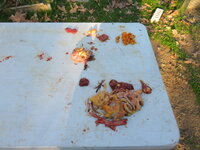Okay, I'm not sure this is the right section for this and I know this is kind of an awkward question. When a chicken dies and you want to do a necropsy to determine the cause of death, how would you proceed? As in, do you gut it like you would when preparing a bird for the table? Do you drain the blood out, do you take the skin with feathers off.. etc. When I did mine, I just began gutting the same way I would if I were doing it for the table, and I was rather displeased. I think the feathers got in the way, and also a lot of the organs seemed damaged when I was finished. So... how do you do your necropsies?
Thanks.
Thanks.




